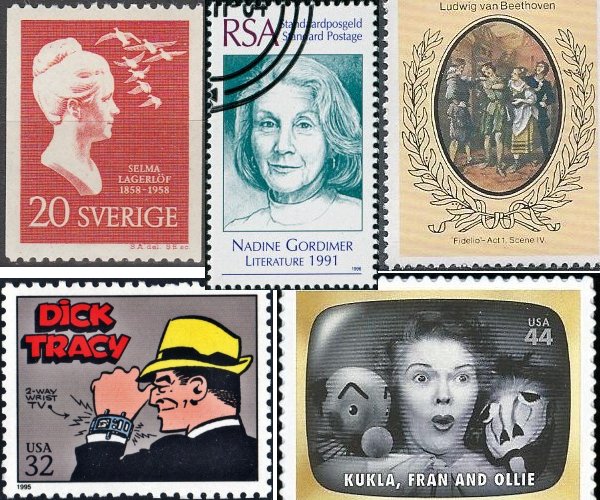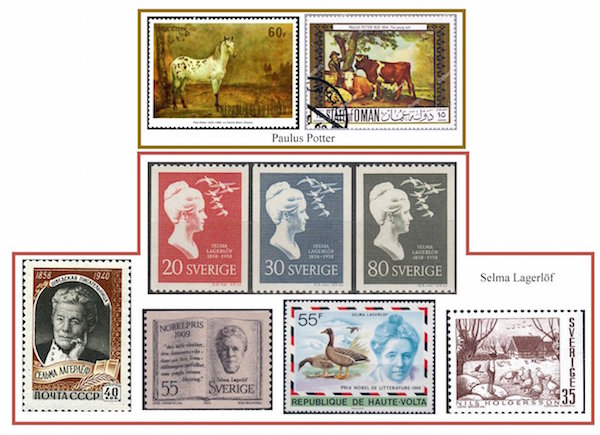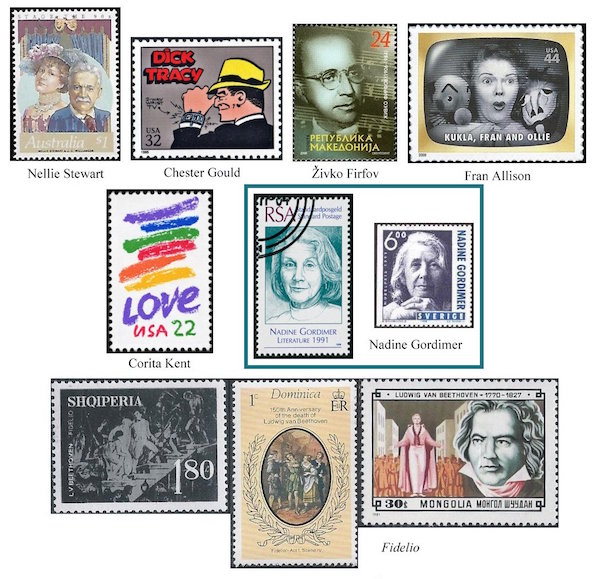The Arts on Stamps of the World — November 20
An Arts Fuse regular feature: the arts on stamps of the world.

By Doug Briscoe
There are more women on today’s The Arts on Stamps of the World than there are men by a ratio of five to three. It’s about time. Two of the women were Nobel Prize winners, Selma Lagerlöf and Nadine Gordimer, and we also acknowledge the creator of Dick Tracy, Chester Gould. In addition, it’s the 212th anniversary of the first performance of Beethoven’s only opera, Fidelio (so you might say it’s six to three).
But, to paraphrase Luca Brasi, let our first child be a masculine child. Dutch painter Paulus Potter was an animalier who lived at various places in the Netherlands: Leiden, Amsterdam, Delft, The Hague. His father was also a painter. We don’t know the birth or death dates for this artist, but he was baptized on 20 November 1625 and buried on 17 January 1654, having died of tuberculosis at age 28. He left about a hundred paintings, including The White Horse, seen on a stamp from Chad, and The Bull (1647), on one from Oman.

Selma Lagerlöf (20 November 1858 – 16 March 1940) was the first woman writer to win the Nobel Prize for Literature. She was a quiet and bookish child who liked to write poetry. As a young adult she taught school and began her first novel, Gösta Berling’s Saga (publ. 1891). She submitted the early chapters in a competition and won, the prize being publication. A few years later she met the Swedish-Jewish writer Sophie Elkan, and they probably became lovers, critiquing each other’s work over the years to come. Lagerlöf was enabled by generosity from the royal family and the Swedish Academy to leave teaching by 1895 and devote herself to her art. In 1902, the National Teacher’s Association asked her to write a children’s geography book, and the result was The Wonderful Adventures of Nils, the story of a boy who is shrunk to thumb size and travels around Sweden on the back of a goose. (Thus the geese on the stamp from Upper Volta—now Burkina Faso—and the illustration on the last stamp at bottom right.) Lagerlöf fought for women’s suffrage and was able to persuade the Swedish royal family to secure the release of her friend the German-Jewish writer Nelly Sachs from Nazi captivity. (Sachs’s birthday is next month.) This was just prior to Lagerlöf’s own death. Lagerlöf’s creations provided fodder to the budding silent film industry, her works being dramatized by such auteurs as Victor Sjöström and Mauritz Stiller. In 1991 Selma Lagerlöf was the first woman to have her image reproduced on a Swedish banknote.
Nellie Stewart (20 November 1858 – 21 June 1931) was a popular Australian actress and operetta singer. Born Eleanor Towzey Stewart into a theatrical family, she was on the stage from the age of five. As an adult she performed in Gilbert and Sullivan and other light opera, eventually mastering three dozen roles. She had a long and loving relationship with the theater manager George Musgrove. In 1888 Stewart sang the role of Marguerite in Gounod‘s Faust at Melbourne for 24 consecutive nights, a remarkable feat, but it was this kind of excess that led to a damaging strain on her voice. “Sweet Nell” came to America and was a great hit in San Francisco, but the 1906 earthquake destroyed all the company’s scenery and ended its planned cross-country tour abruptly. She appeared in a single film in 1911. The 1989 postage stamp pairs her with American-born actor and theater manager J. C. Williamson.
Dick Tracy was the brainchild of American cartoonist Chester Gould (November 20, 1900 – May 11, 1985), who wrote and drew the comic strip for over 45 years, from 1931 to 1977. But he had had other strips going back as early as 1924. Toward the end of Gould’s run, Dick Tracy came in for a heavy share of criticism for its blind support of police power and its callousness regarding civil rights, as well as for weaknesses in plotting. Al Capp, no bleeding heart, satirized Dick Tracy in his own Li’l Abner strip with the character of Fearless Fosdick. But for those who can’t get enough Dick Tracy, the complete run of the comic strip is in the process of being republished in book form. Since 2006 nineteen volumes have appeared, bringing us up to February 1961.
Macedonian ethnomusicologist, teacher, and conductor Živko Firfov was born on this day in 1906 and died 21 July 1984. He wrote about a dozen film scores and a handful of other small pieces. He was a founder of the folk music group Tanec (“The Ensemble”). OK, no more men today.

Both of our next two subjects happen to have been born in Iowa, and both were named Frances. Fran Allison (November 20, 1907 – June 13, 1989) was the “Fran” of the children’s puppet show Kukla, Fran and Ollie (1947-57). She taught fourth grade for a while before working in radio in Cedar Rapids and Chicago, where from 1937 she was a singer and on-air personality with NBC Radio. When a new children’s program was proposed for WBKB-TV, Allison was brought on board as the only human character. Her function was to play “den mother” and lovingly settle disputes among the hyperactive puppets, the Kuklapolitan Players. Allison went on to appear in a number of other television programs and to record songs, racking up two minor pop hits. She was always a devoted mental health advocate.
The American artist Corita Kent (November 20, 1918 – September 18, 1986) is the person who gave Bostonian commuters the design they have seen thousands of times, the Rainbow Swash on the LNG storage tank by the Central Artery. Kent was born Frances Elizabeth Kent 99 years ago today and became a Catholic nun at an early age, joining the order of the Sisters of the Immaculate Heart of Mary in Los Angeles in 1936. At that time she took the name Sister Mary Corita. She studied art at Otis and Chouinard as well as at Immaculate Heart College, from which she earned her BA. With the 1960s she became more of an activist, earning recriminations from the right wing, notably the reactionary Cardinal James McIntyre, who called her art “blasphemous” (he would later be responsible for shutting down Immaculate Heart College in 1980 for being too “liberal”), and she returned to the secular life in 1968. From Los Angeles Kent came to Boston, where her 1971 painting of the storage tank again caused controversy, because many people saw in the swath of blue a profile of Ho Chi Minh. Kent always denied the intent, and to me she hardly seems the kind of person who would lie about such things. Diagnosed with cancer in 1974, she only intensified her output, although limiting herself to watercolors and the occasional print. We can include Kent here on AoSotW because she designed the 1985 Love stamp shown in our collage. She had hoped and expected that the unveiling would take place at the UN, and when she learned it would be held on the Love Boat she refused to show up. The stamp sold 700 million copies. Corita Kent died in Watertown.
A great writer and a great champion of civil rights, the late Nobel Prize-winning South African author Nadine Gordimer (20 November 1923 – 13 July 2014) was a tireless and courageous fighter for justice. Her parents were secular Jewish, an immigrant watchmaker from what is now Lithuania and a woman from London. Nadine, mostly home-schooled, wrote from childhood and published her first story at 15. This was a children’s story, and her first adult fiction saw publication the very next year. Her career took off after the New Yorker accepted a story in 1951. She would, of course, go on to provide the magazine with many, many more. Her first novel, The Lying Days, came out in 1953, and it wasn’t really until 1960 or so that Gordimer became more involved in civil rights, especially but not exclusively as an anti-apartheid activist. She developed close friendships with Nelson Mandela’s defense attorneys in 1962 and helped him edit the speech he gave from the defendant’s dock. She joined the ANC while it was still illegal and hid refugees in her home. Needless to say, the loathsome and despicable South African government banned and censored her works, The Late Bourgeois World (1976) being banned for ten years, A World of Strangers for twelve. In later years, Gordimer was active in the HIV/AIDS movement. Her Nobel Prize was awarded in 1991.
Beethoven’s only opera Fidelio had its première (under the title Leonore) in Vienna on this date in 1805. “Fidelio” (the faithful one) is the name assumed by Leonore to gain access to the jail where her husband Florestan is being held as a political prisoner. She fools everybody into thinking she’s a young man and saves the day. Two of the stamps shown are from multi-issue Beethoven series, while the Mongolian one comes from a group of composer stamps and shows a scene from the opera.
Worthy of note but not yet a stamp are Alistair Cooke (20 November 1908 – 30 March 2004) and Don DeLillo (born November 20, 1936).
A graduate of the University of Massachusetts with a B.A. in English, Doug Briscoe worked in Boston classical music radio, at WCRB, WGBH, and WBUR, for about 25 years, beginning in 1977. He has the curious distinction of having succeeded Robert J. Lurtsema twice, first as host of WGBH’s weekday morning classical music program in 1993, then as host of the weekend program when Robert J.’s health failed in 2000. Doug also wrote liner notes for several of the late Gunther Schuller’s GM Recordings releases as well as program notes for the Boston Classical Orchestra. For the past few years he’s been posting a Facebook “blog” of classical music on stamps of the world, which has now been expanded to encompass all the arts for The Arts Fuse.
